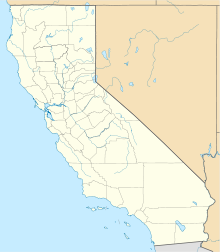Mountain Pass rare earth mine

The Mountain Pass mine surface facilities. The upper part of the open pit is seen in the background.
|
|
| Location | |
|---|---|
| Location | Mountain Pass, San Bernardino County |
| State | California |
| Country | United States |
| Coordinates | 35°29′N 115°32′W / 35.48°N 115.53°WCoordinates: 35°29′N 115°32′W / 35.48°N 115.53°W |
| Production | |
| Products | Rare earth elements |
The Mountain Pass Rare Earth Mine is an open-pit mine of rare earth elements (REEs) on the south flank of the Clark Mountain Range, just north of the unincorporated community of Mountain Pass, California, United States. The mine, owned by Molycorp Inc., once supplied most of the world's rare earth elements. Molycorp is in bankruptcy proceedings as of Jan 2016.
The Mountain Pass deposit is in a 1.4 billion year old Precambrian carbonatite intruded into gneiss, and contains 8% to 12% rare earth oxides, mostly contained in the mineral bastnäsite.Gangue minerals include calcite, barite, and dolomite. It is regarded as a world-class rare-earth mineral deposit. The metals that can be extracted from it include:
Known remaining reserves were estimated to exceed 20 million tons of ore as of 2008, using a 5% cutoff grade, and averaging 8.9% rare earth oxides.
The bastnäsite ore was finely ground, and subjected to froth flotation to separate the bulk of the bastnäsite from the accompanying barite, calcite, and dolomite. Marketable products include each of the major intermediates of the ore dressing process: flotation concentrate, acid-washed flotation concentrate, calcined acid-washed bastnäsite, and finally a cerium concentrate, which was the insoluble residue left after the calcined bastnäsite had been leached with hydrochloric acid.
The lanthanides that dissolved as a result of the acid treatment were subjected to solvent extraction, to capture the europium, and purify the other individual components of the ore. A further product included a lanthanide mix, depleted of much of the cerium, and essentially all of samarium and heavier lanthanides. The calcination of bastnäsite had driven off the carbon dioxide content, leaving an oxide-fluoride, in which the cerium content had become oxidized to the less-basic quadrivalent state. However, the high temperature of the calcination gave less-reactive oxide, and the use of hydrochloric acid, which can cause reduction of quadrivalent cerium, led to an incomplete separation of cerium and the trivalent lanthanides.
...
Wikipedia

